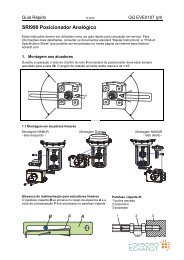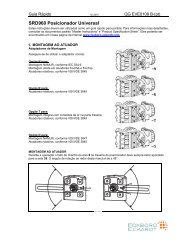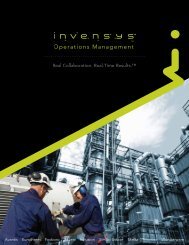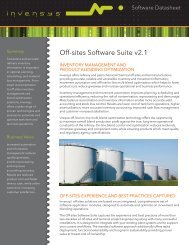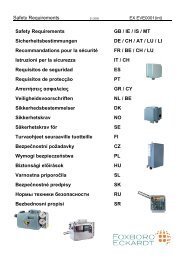Oleum Acid Measurement - Invensys Operations Management
Oleum Acid Measurement - Invensys Operations Management
Oleum Acid Measurement - Invensys Operations Management
Create successful ePaper yourself
Turn your PDF publications into a flip-book with our unique Google optimized e-Paper software.
<strong>Oleum</strong> <strong>Acid</strong> <strong>Measurement</strong><br />
INTRODUCTION<br />
<strong>Oleum</strong> (fuming sulfuric acid, H2S2O7) is<br />
corrosive and commonly made in various<br />
strengths, consisting of SO3 dissolved<br />
in 100% H2SO4. Therefore, 20% oleum<br />
contains 20% SO3 and 80% H2SO4 by<br />
weight. Contingent on strength, vapor<br />
pressure is such that escaping SO3 fumes<br />
combine with moisture in the air to form<br />
sulfuric acid mist particles. These sulfuric<br />
acid mist particles are typically visible and<br />
can create dense white clouds of fumes.<br />
• Normally turbid, off-white liquid<br />
• Solution of uncombined SO3 dissolved in H2SO4<br />
• <strong>Oleum</strong> sometimes referred to as greater than 100% H2SO4<br />
Application<br />
Solution
USES<br />
• In sulfonation and nitration processes<br />
• Leading source of sulfonation for powdered/synthetic laundry products<br />
• High-strength adhesives<br />
• Insecticides<br />
• Oil refining<br />
• Explosives<br />
PRODUCTION<br />
Typically, oleum is produced as part of the commercial process of manufacturing sulfuric acid. Today<br />
essentially all sulfuric acid and oleum produced in the United States is manufactured using the contact<br />
method. The contact method incorporates three basic operations, each of which corresponds to a<br />
distinct chemical reaction. The basic raw materials for sulfuric acid are sulfur, air, and water.<br />
First — the sulfur feedstock (molten sulfur or sulfur containing ore) is oxidized (burned in air) to sulfur<br />
dioxide (SO2).<br />
Next — the sulfur dioxide is fed to a process unit called a converter, where it is catalytically (such as<br />
vanadium pentoxide catalyst or platinum) oxidized (at 450° Celsius) to sulfur trioxide (SO3).<br />
Finally — the sulfur trioxide is absorbed in a strong 98% sulfuric acid solution (fuming sulfuric acid<br />
or oleum). Final sulfuric acid product is sent to storage tanks. Conductivity measurements are often<br />
considered for the oleum tower line and the recirculation line between the tower and tank. Typical<br />
percent concentration ranges encountered in industry for oleum are 0 to 10% or 42 to 18% oleum, and<br />
for sulfuric acid are from 99.5 to 93% and 0 to 25% H2SO4 (occasionally mid-ranges).<br />
APPLICATION CHALLENGES — CURVE SHAPE<br />
Conductivity vs. percent by weight vs. temperature<br />
<strong>Oleum</strong>, occasionally referred to in terms of greater than 100% sulfuric acid concentration. However,<br />
like most binary solutions, oleum exhibits a generally bell-shaped conductivity versus concentration<br />
by weight curve. It exhibits a front slope (0% to 10% oleum) and a back slope (42% to 18% oleum).<br />
Typically, when referring to the back slope of a<br />
conductivity curve, the concentration ranges are reversed<br />
(such as 42% to 18%), because the lowest conductivity<br />
is actually the higher percent concentration. As with<br />
any conductivity measurement, it is imperative to utilize<br />
the most accurate conductivity versus concentration<br />
(by weight) and temperature compensation curve set(s)<br />
available. Foxboro ® offers oleum front slope and back<br />
slope percent concentration curve sets as standard.<br />
Furthermore, since a single conductivity can report to<br />
more than one concentration on many bell-shaped<br />
curves, conductivity measurements are typically restricted<br />
to a single, linear curve section. In addition, conductivity<br />
increases with temperature, so the curve shape(s) can and<br />
do change as the process temperature changes.<br />
Per Corrosion Resistance Tables, Fourth edition — Schweitzer
This matrix identifies oleum<br />
a. The standard curves resident in memory in an 875EC Communicator or an 870ITEC Intelligent Transmitter<br />
b. The temperature compensation range and the reference temperature of each standard curve<br />
c. Some typical conductivity values for low-, mid-, and high-end percent concentrations at reference<br />
temperature, relative to the standard curve solutions<br />
The conductivity values provided (above) have been gleaned from data published by numerous sources, and are to be<br />
considered estimations only. Since no two sources are likely to completely agree on the “conductivity” of a solution, this<br />
table should be used as a reference source only. Ultimately, any precise conductivity values required should be determined<br />
independently. Often the most representative data is derived on-site. For conductivity or material compatibility information<br />
relative to either Standard or Custom curve solutions, contact <strong>Invensys</strong>.<br />
Compatibility<br />
For general manufacturing, sensor selection is a critical aspect<br />
of any oleum acid measurement. Typically, there are various<br />
wetted materials to consider (such as thermoplastics, O-rings,<br />
and metals), where process compatibility decisions are based on<br />
maximum process temperature and percent acid concentration<br />
range. The most appropriate wetted materials will change<br />
relative to these process factors, though different sensor material<br />
selections are typically not required for front slope (0% to 10%)<br />
versus high-concentration (42% to 18%) oleum applications (as<br />
they might for sulfuric acid measurements less than 100%). An<br />
exception would be those very atypical applications seeking<br />
to measure 65% oleum. Foxboro offers a sensor that routinely<br />
provides long life in even this unusually severe environment.<br />
Installation<br />
Sensor installation must also be considered as one of the<br />
potentially critical application decisions. Whether invasive<br />
or flowthrough sensor design, the sensor selection must be<br />
made relative to the application parameters (such as maximum<br />
process temperature, process line pressure, maximum percent<br />
concentration), as the sensor selected may impact frequency and<br />
ease of calibration and/or exposure of personnel.<br />
Foxboro Product Application Solutions –<br />
Curves for 875EC Intelligent Analyzer<br />
The Foxboro 875EC Intelligent Analyzer (four-wire, V ac) and<br />
870ITEC Intelligent Transmitter (two-wire, V dc) offer standard<br />
oleum curve sets for 0% to 10% and 42% to 18%, both at 65°<br />
C reference temperature (and more than 18 other standard<br />
binary solution curve sets). In addition, they offer multiple<br />
application capability (up to three distinct application range and<br />
temperature compensation curve sets), any combination of which<br />
may be standard or custom curves, and can be calibrated into<br />
memory. They may also be employed with the capability to autoswitch<br />
from one calibrated application to another. These uniqueto-Foxboro<br />
features essentially permit the accurate measurement<br />
of the entire oleum acid concentration range by utilizing either
the standard 0 to 10% curve set for front slope measurements, or the standard 42 to 18% (back slope)<br />
curve set. Dilutions across the back-to-front slope range are possible by utilizing the Foxboro-unique<br />
multiple application capability with the auto-switch feature.<br />
Material Compatibility<br />
Foxboro offers the widest array of electrodeless conductivity sensors in the industry. Among these are<br />
invasive sensors and offer a wide selection of wetted materials, including metals, thermoplastics, and<br />
O-rings (such as the 871EC series) compatible with typical oleum applications and all thermoplastic<br />
sensors (such as the EP307B series) or borosilicate glass sensors (such as EP307G series) for the most<br />
aggressive oleum applications.<br />
In addition, the noninvasive Foxboro 871FT Industrial Flowthrough electrodeless conductivity sensor<br />
series solves many historically encountered application problems. Instead of installing an insertiontype<br />
sensor, the Industrial Flowthrough sensor becomes a section of the process line. A wide selection<br />
of bore sizes (0.5, 1.0, 1.5, 2.0, 3.0, or 4.0 inch) permits the selected sensor to match the size of the<br />
process line and become a section of the process line. The 871FT Flowthrough sensors may also be<br />
selected from a wide list of compatible wetted materials.<br />
Installation<br />
Foxboro 871FT series Industrial Flowthrough sensors permit calibration in-line without exposing<br />
personnel or the environment to aggressive and dangerous chemicals, thereby reducing calibration<br />
time and expense. Foxboro’s EP485A series calibration plugs further increases accuracy and reduces<br />
completion time for the calibration.<br />
REFERENCE DOCUMENTATION<br />
Sensors:<br />
871EC-TF2-V (ref. PSS 6-3C4A)<br />
Analyzer/Transmitter:<br />
875EC Intelligent Analyzer (Ref. PSS 6-3N1C)<br />
870ITEC Intelligent 2 wire Transmitter (Ref. PSS 6-3N2A)<br />
<strong>Invensys</strong> <strong>Operations</strong> <strong>Management</strong> • 5601 Granite Parkway III, #1000, Plano, TX 75024 • Tel: (469) 365-6400 • Fax: (469) 365-6401 • iom.invensys.com<br />
<strong>Invensys</strong>, the <strong>Invensys</strong> logo, ArchestrA, Avantis, Eurotherm, Foxboro, IMServ, InFusion, SimSci-Esscor, Triconex, and Wonderware are trademarks of <strong>Invensys</strong> plc, its subsidiaries or affiliates. All other<br />
brands and product names may be the trademarks or service marks of their representative owners.<br />
© 2010 <strong>Invensys</strong> Systems, Inc. All rights reserved. No part of the material protected by this copyright may be reproduced or utilized in any form or by any means, electronic or mechanical, including<br />
photocopying, recording, broadcasting, or by any information storage and retrieval system, without permission in writing from <strong>Invensys</strong> Systems, Inc.<br />
Rel. 02/10


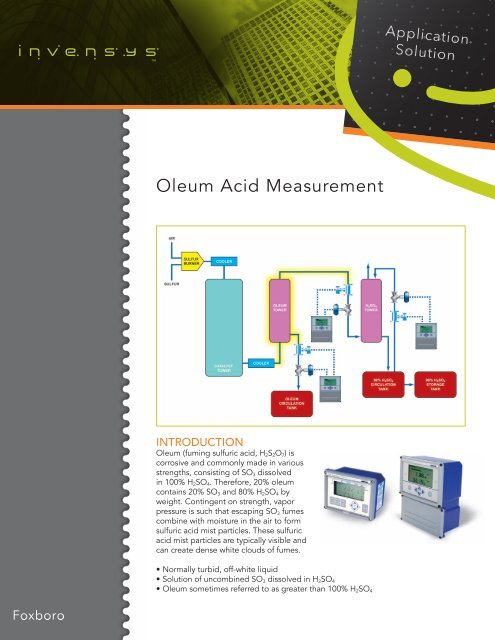

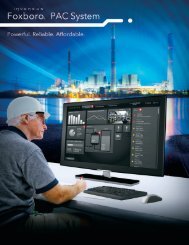
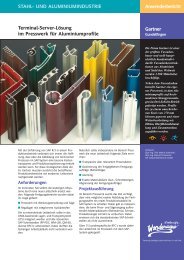
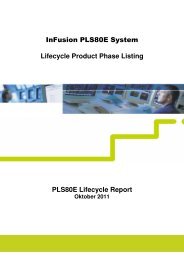
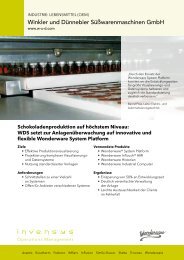
![[MI 019-179] Veiligheidsinformatie stromingsproducten - Invensys](https://img.yumpu.com/19988828/1/190x245/mi-019-179-veiligheidsinformatie-stromingsproducten-invensys.jpg?quality=85)
